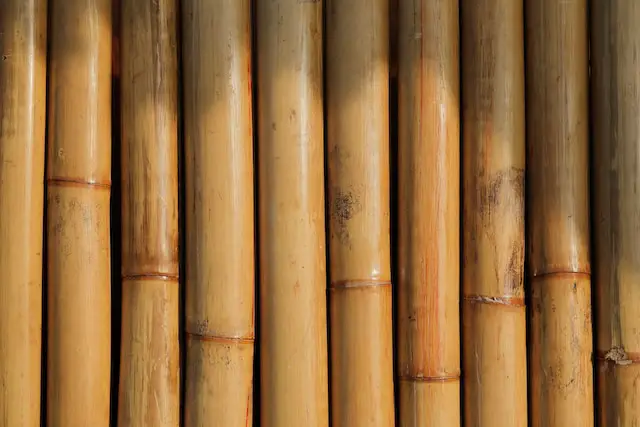Bamboo is a type of grass with a hollow stem that grows in a variety of climates and is often used for construction and furniture. Rattan, on the other hand, is a type of vine that grows in tropical regions and is typically used for making furniture and woven products.
What is bamboo?
(Photo by Maksim Shutov on Unsplash )

Bamboo is a type of grass that belongs to the Poaceae family. It has a hollow stem and grows in a wide range of climates, from tropical to temperate regions. Bamboo is known for its strength, flexibility, and rapid growth, which makes it a popular material for a variety of applications, including construction, furniture, paper, textiles, and even food.
What is rattan?
(Photo By Kent Wang on flickr)

Rattan is a species of palm that is native to the tropical forests of Africa, Asia, and Australasia. The plant has slender stems that can grow up to 30 meters in length. Rattan is often used in furniture and baskets because of its strong, flexible nature.
Bamboo Vs. Rattan – Key differences
Bamboo and rattan are both natural materials that are commonly used in furniture and home decor, but there are some key differences between them:
Plant Type: Bamboo is a type of grass with a hollow stem, while rattan is a type of climbing palm vine.
Physical Characteristics: Bamboo has a hard, woody texture and is typically solid or hollow, with a smooth or slightly rough surface. Rattan, on the other hand, has a thin, flexible stem with a naturally rough surface that is often peeled or split to make it easier to work with.
Growing Environment: Bamboo can grow in a wide range of climates, from tropical to temperate regions, while rattan typically grows in warm, humid tropical climates.
Usage: Bamboo is often used for construction, furniture, paper, textiles, and even food. Rattan is primarily used for furniture and woven products like baskets and mats.
Sustainability: Both bamboo and rattan are considered sustainable materials, but bamboo is often considered more sustainable because it grows faster and can be harvested without killing the plant, whereas rattan can only be harvested once every few years and the plant is often destroyed in the process.
What is bamboo used for?
Bamboo has a wide range of uses, including:
- Construction: Bamboo is a strong, lightweight material that can be used for building homes, bridges, and other structures.
- Furniture: Bamboo is often used to make furniture, such as chairs, tables, and shelves.
- Textiles: Bamboo fibers are used to make a variety of textiles, including clothing, towels, and bedding.
- Paper: Bamboo pulp is used to make high-quality paper that is durable and eco-friendly.
- Food: Bamboo shoots are a popular ingredient in many Asian dishes and can be pickled, stir-fried, or added to soups.
- Musical Instruments: Bamboo is used to make a variety of musical instruments, including flutes, drums, and xylophones.
- Garden and Landscaping: Bamboo is often used in landscaping and gardening to create fences, trellises, and privacy screens.
- Crafts: Bamboo is a popular material for a variety of crafts, including basket weaving, carving, and origami.
What is rattan used for?
Rattan is a versatile material that is primarily used for furniture and home décor. Here are some common uses of rattan:
- Furniture: Rattan is a popular material for making furniture such as chairs, tables, sofas, and headboards. It is lightweight, durable, and has a natural aesthetic that complements a variety of styles.
- Woven Products: Rattan is also used to make woven products such as baskets, trays, and mats.
- Home Décor: Rattan is used for decorative items such as lampshades, room dividers, and wall hangings.
- Garden and Outdoor Furniture: Rattan is suitable for outdoor furniture due to its resistance to weather and durability.
- Musical Instruments: Rattan is used to make percussion instruments such as maracas and claves.
- Handicrafts: Rattan is used to create a range of handicrafts, including sculptures, masks, and ornaments.
The benefits and drawbacks of bamboo and rattan
Benefits of Bamboo:
- Sustainability: Bamboo is a highly sustainable material due to its rapid growth and ability to regenerate quickly.
- Strength and Durability: Bamboo is a strong and durable material that can withstand a lot of wear and tear, making it ideal for construction and furniture.
- Versatility: Bamboo has a wide range of uses, from construction to textiles and food.
- Aesthetics: Bamboo has a unique look and natural beauty that can add warmth and character to any space.
Drawbacks of Bamboo:
- Processing: The processing of bamboo can be labor-intensive and require specialized machinery.
- Transportation: Bamboo is typically grown in tropical regions, which can increase transportation costs and carbon footprint.
Benefits of Rattan:
- Sustainability: Rattan is a sustainable material that can be harvested without killing the plant, making it a renewable resource.
- Natural Aesthetics: Rattan has a natural, rustic look that can add warmth and character to any space.
- Lightweight and Flexible: Rattan is lightweight and flexible, making it easy to work with and ideal for weaving.
- Durable: Rattan is a durable material that can withstand a lot of wear and tear, making it ideal for furniture.
Drawbacks of Rattan:
- Limited Usage: Rattan is primarily used for furniture and woven products, which can limit its versatility.
- Vulnerable to Weather: Rattan can be vulnerable to moisture and weather, which can cause it to weaken and break over time.
- Processing: The processing of rattan can be labor-intensive and require specialized machinery.
- Limited Growing Areas: Rattan typically grows in tropical regions, which can limit its availability and increase transportation costs.
What are the types of rattan?
There are several types of rattan, each with its own unique characteristics and uses. Some of the most common types of rattan include:
- Manau: This is a strong and durable type of rattan that is often used for furniture and basket weaving.
- Malacca: This type of rattan is known for its flexibility and is commonly used for weaving furniture, baskets, and other products.
- Tohiti: This type of rattan has a finer texture and is often used for making decorative items like lampshades and baskets.
- Batangas: This type of rattan is native to the Philippines and is known for its strength and durability.
- Calamus: This is a type of rattan that is native to Africa and is often used for weaving baskets and other products.
- Pernambuco: This type of rattan is native to Brazil and is known for its strength and flexibility. It is often used for making furniture and musical instruments.
- Wicker: Wicker is not a type of rattan, but rather a weaving technique that can be used with many different materials, including rattan.
These are just a few examples of the many different types of rattan that are used in furniture and handicrafts. The specific type of rattan used will depend on the intended use and desired characteristics of the finished product.
Which is better bamboo or rattan?
When it comes to bamboo or rattan, there is no definitive answer as to which material is better. It ultimately depends on your personal preferences and needs. Bamboo is a fast-growing grass that is known for its durability, while rattan is a type of vine that is often used in furniture construction. Both materials have their own unique benefits that make them ideal for different purposes.
If you’re looking for a durable material for your furniture, then bamboo may be the better option. Bamboo is incredibly strong and can withstand a lot of wear and tear. Additionally, bamboo is also environmentally friendly since it’s a sustainable resource. On the other hand, rattan is also a very strong material, but it’s typically lighter than bamboo. This makes it ideal for furniture that needs to be moved around frequently. Rattan is also more flexible than bamboo, so it can be used to create intricate designs.
Ultimately, the decision of which material to use comes down to personal preference and what you need the furniture for. If you need something durable and eco-friendly, then bamboo may be the better option. However, if you need something light and easy to move, then rattan would be the better choice.
Featured Image By – Eleonora Albasi on Unsplash








